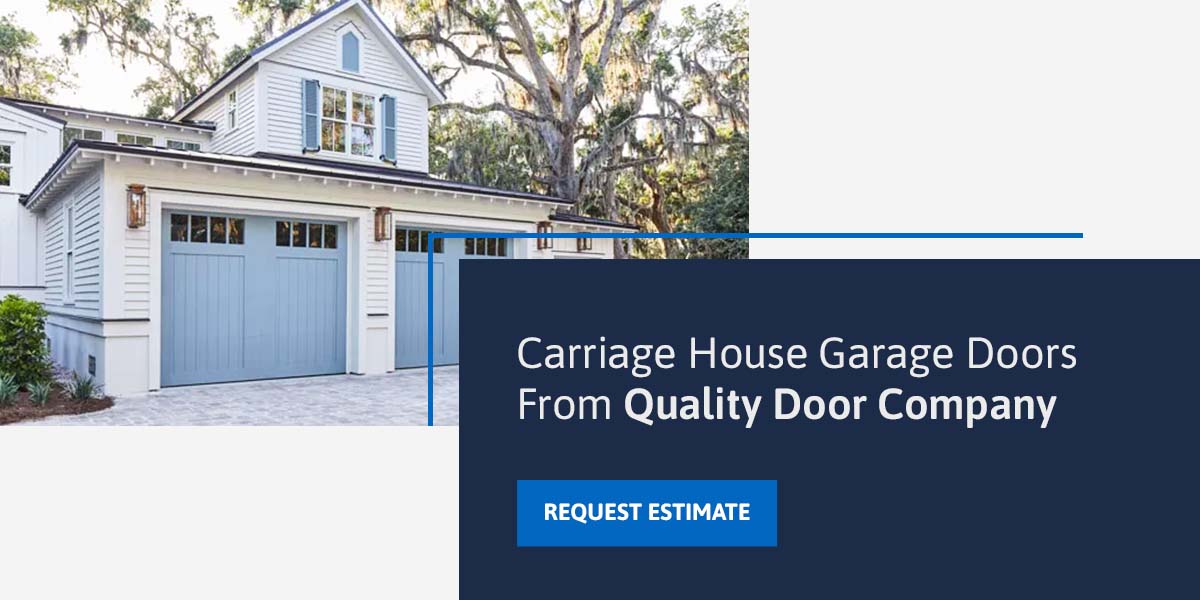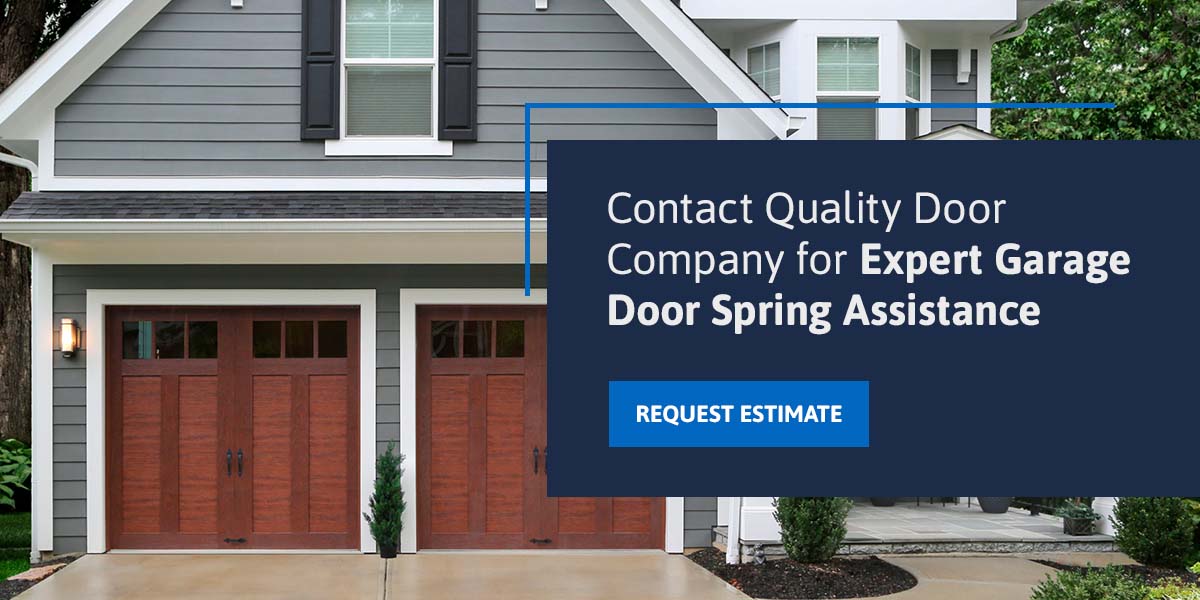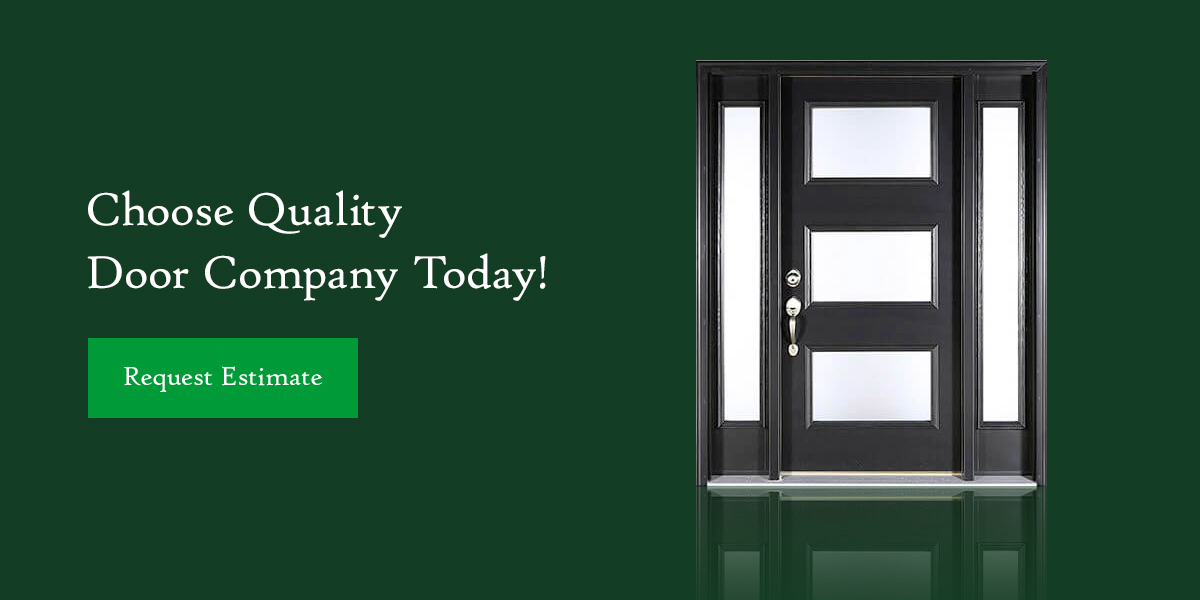Style Guide to Carriage House Garage Doors
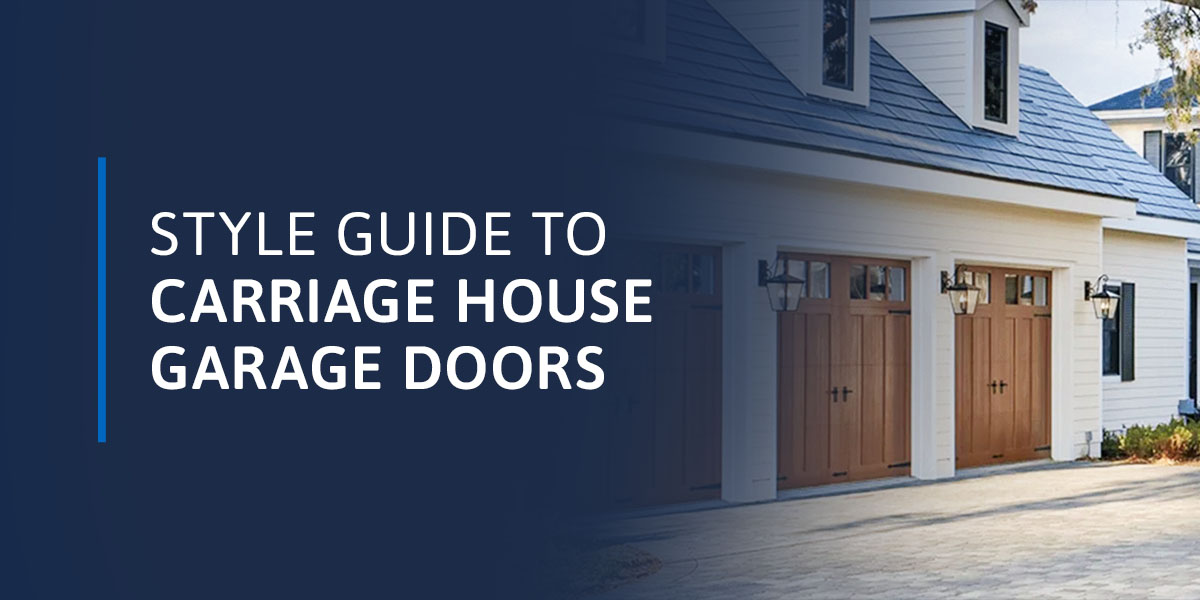
As a Michigan homeowner, you appreciate the value of a sturdy garage door that can withstand rough winters. But there’s more to selecting a garage door than performance. If you’re considering a new garage door installation, you probably want one that offers excellent functionality and pleasing aesthetics.
While there are plenty of options on the market, if you’re looking for a unique garage door that matches both traditional and modern homes, consider installing a carriage house garage door. Learn more in our carriage house style guide.
What Is a Carriage House Garage Door?
A carriage house garage door is a modern garage door designed to resemble the traditional carriage house doors or coach house doors dating back to the 1700s. Also known as barn-style doors, the original doors stood on hinges and swung sideways to let in horse-drawn carriages. While carriage house garage doors adopt the aesthetics of the historic coach house doors, they maintain the modern garage door overhead feature, where they roll upward.
What Makes Carriage House Garage Doors Different?
What makes a carriage house garage door unique is its history. The old-world look has a timeless appeal that brings a touch of elegance to different home designs. Aside from the charm that comes with classic architectural styles like farmhouse, rustic and vintage, these doors also provide the convenience of modern operation.
For instance, unlike the original carriage doors, the modern versions offer the same functionality and design features as standard overhead garage doors. These features may include weather-resistant materials, insulation, smart technology and safety mechanisms. As a result, carriage house garage doors go beyond the standard door features.
Carriage House Garage Door Designs
Carriage house garage door designs vary based on materials and design elements, offering many options. While it’s a single, unique garage door type, design versatility eliminates sameness. Here are some of the common carriage house garage door styles on the market:
Canyon Ridge®
Canyon Ridge® is a Clopay® series featuring diverse carriage house garage doors to complement different architectural styles and personal preferences. The popular series has everything from traditional-looking carriage house types to more modern variations.
The more traditional styles, like the Canyon Ridge® Carriage House (5-Layer) and its four-layer option, replicate the aesthetics of coach house designs, making them a perfect choice if you want to capture the charm and realism of the old world. In contrast, Canyon Ridge® Modern blends the classic style with modern elements like clean lines and metallic accents, which add sophistication.
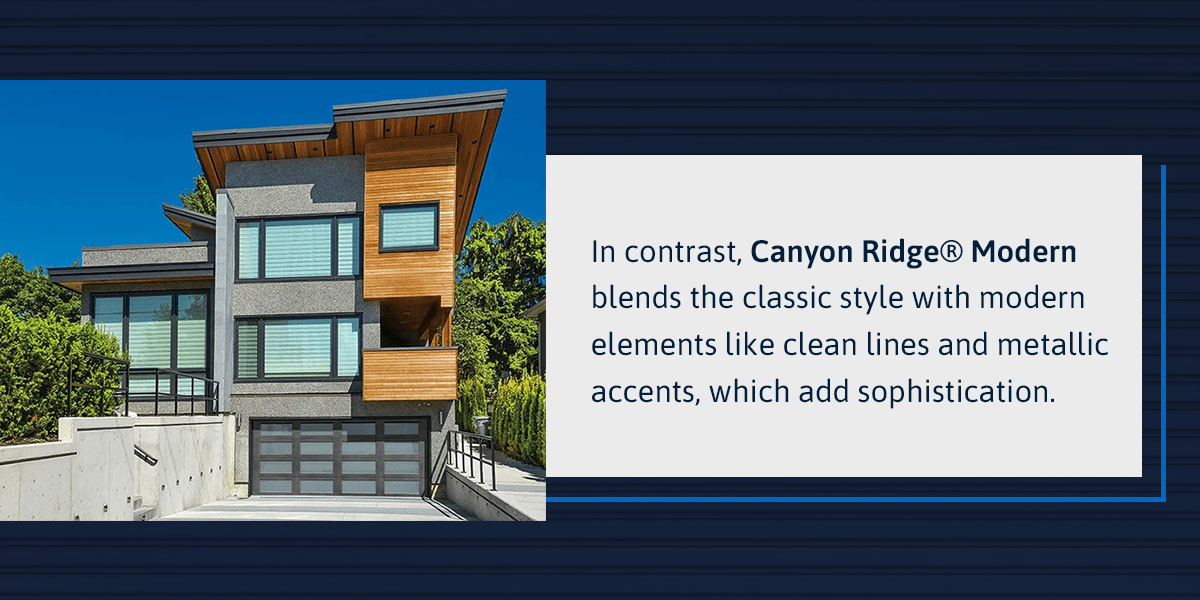
Bridgeport™ Steel
While steel garage doors are a modern invention, Clopay’s Bridgeport™ Steel opens the carriage house style to new possibilities. As a faux wood collection, Bridgeport Steel has a wood look and finish that allows it to imitate carriage house doors while maintaining the superior performance and durability of steel.
Bridgeport Steel offers plenty of design and color variations. For a classic look, you can opt for the large, horizontal recessed panels. These doors also come with various top-section options like arches for more diversity.
Coachman®
Like Canyon Ridge, Coachman garage doors have some of the most authentic carriage house door appearance. Despite modern qualities like the roll-up feature, these garage doors often display traditional hinges and handles similar to those that came with the historic swing-out doors.
While Coachman doors are designed for practicality, they also maximize aesthetics to attain the original carriage house door look. The doors are made from durable steel and feature other technologies like rust prevention and insulation for convenience. However, using woodgrain-textured composite overlays gives the doors their natural wood appearance.
Gallery® Steel
Gallery Steel is a high-strength garage door collection with a three-layer construction that provides durability, insulation, and dent resistance. It also offers a beautiful carriage house look with multiple design options, such as long and short panels, top section and window options.
Gallery steel garage doors feature four types of oak woodgrain finishes to capture the look of a wood carriage house style. Optional hardware such as strap hinges, lift handles and step plates — available in spade, spear and colonial designs — are perfect accessories for adding more authenticity to the door’s appearance.
Benefits of Carriage House Garage Doors
Carriage house garage doors combine classic aesthetics with modern features, offering several advantages. Here are some of the benefits of carriage house doors:
- Increased curb appeal: Carriage house garage doors are designed to replicate the historic coach house doors. Their distinctive look and various design options give the doors much character, transforming them into exterior centerpieces for diverse home designs.
- Versatile designs: Modern carriage house garage doors are made from different materials, from solid wood for the most authentic look to metal with faux wood overlays. They are also available in various panel designs, top-section choices, decorative accents and finishes. The versatility makes it easy to customize these doors to complement any architectural style.
- High durability and longevity: Unlike the old carriage house doors, modern versions are often made from more durable and long-lasting materials like steel, composite wood and fiberglass. Due to multi-layer technology during construction, these doors offer exceptional durability, reliable performance and improved longevity.
- Increased property value: One survey shows garage door remodels had the highest return on investment in 2024. Considering the high-end look of carriage house doors, they may boost your home’s resale value due to the enhanced curb appeal.
How to Choose a Carriage House Garage Door
Carriage-style garage doors come in multiple designs, so choosing one that complements your home depends on several variables. Here are things to consider when selecting a carriage house garage door:
- Color: Like other garage doors, carriage-style doors offer a wide range of color options, from traditional white and natural wood finishes to bold colors. You want to select a color or woodgrain finish that complements your home.
- Design: Certain design elements, such as panel pattern, top-section appearance and finishes, can affect how the garage door complements your home’s aesthetics. Consider the wide range of design options, from horizontal and narrow panels to barn-style lumber crosses, for a suitable door that pairs well with your architecture.
- Hardware: Carriage doors come with various decorative hardware options that enhance the style. You’ll need to decide if adding hardware will elevate your home’s appearance. If you opt for hardware, select from pieces such as wrought iron for the top section or handles and hinges.
Carriage House Garage Doors From Quality Door Company
Our carriage house garage style guide explores the unique features of these beautiful doors and their long history. If you’re interested in a perfect balance of style, elegance and performance, a carriage house garage door should top your list. It’s also worth noting that quality and correct installation affect how well your garage door serves you.
At Quality Door Company, we carry products from top brands in the industry, ensuring exceptional quality and reliability. We also provide professional garage door installation and maintenance services. Explore our broad selection of garage doors to select one that suits your needs!
Broken Garage Door Spring — What Are the Causes?
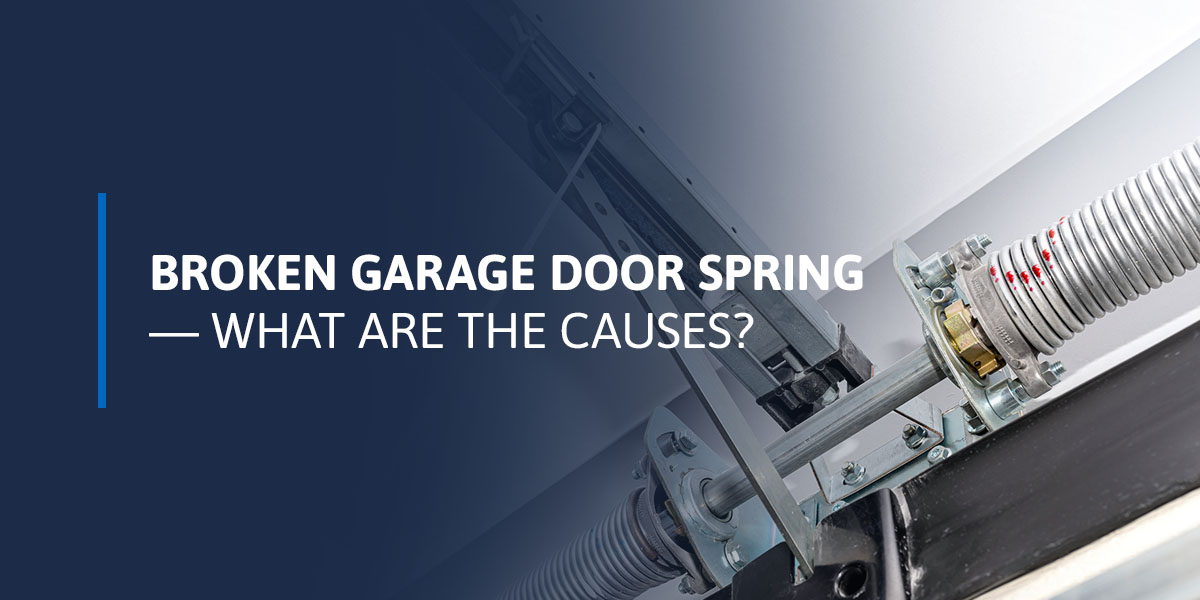
Garage door springs are probably not something you think about every day, especially not while your garage door is in perfect working condition. However, springs are very important for the overall functionality of a garage door.
Operating a garage door continuously exerts extreme forces on the springs, which may lead them to eventually break. Understanding the causes of a broken garage door spring will help you identify when your garage door needs service.
How Do Garage Door Springs Work?
Garage door springs are essential to open and close your garage door daily. They counterbalance the door’s weight, making it possible to open and close. The two main types of residential garage door springs are:
- Torsion springs connect to the lifting cable. They wind up to store energy and unwind to release it, which helps open and close the garage door.
- Extension springs stretch horizontally on each side of the door. They expand and contract to counter the door’s weight.
Both types of springs follow Hooke’s Law of elasticity. You don’t need to comprehensively understand the science behind the mechanical workings of garage door springs — that’s what expert garage door technicians are for.
Signs of a Broken Garage Door Spring
Several signs may indicate a broken garage door spring, or one about to break:
- Loud noises: At first, you may hear loud noises as the spring unwinds, leading up to an unexpected noise that sounds like a loud bang or slam when the spring breaks. Your door may slam into the ground quickly.
- An unbalanced door: Your door’s movement may be uneven or one side will move faster than the other. It may also sag on one side.
- An immobile door: Your garage door may start moving slower as it gets heavier. Your door may open only a few inches before it gets stuck or it may not open at all.
- Noticeable damage: You may notice damage, such as gaps in the springs, rusted springs, snapped springs or loose cables.
If you notice these common signs, you should seek emergency repair and maintenance services to prevent accidents or further damage to your garage door. Spring repair can be dangerous and is best undertaken by a garage door professional.
Why Do Garage Door Springs Break?
There are several reasons garage door springs break. Some known causes may be unavoidable, while others may be managed with the right protocols and preventive maintenance.
Incorrect Spring Type or Installation
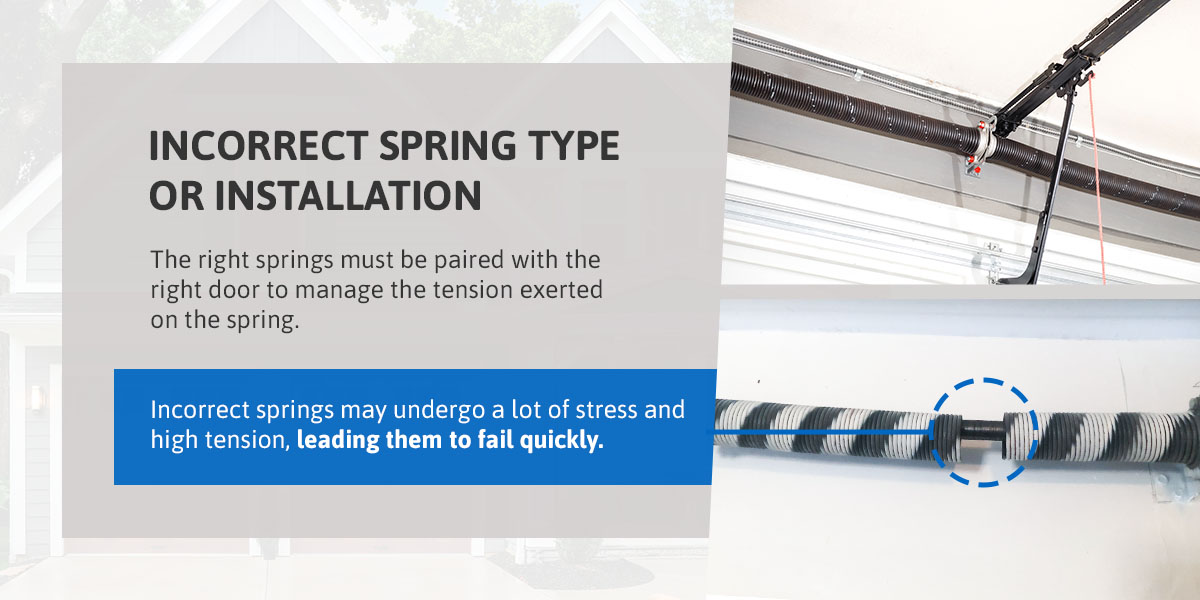
It’s critical to use trusted garage door technicians for assistance with selecting the correct springs and performing the installation. The right springs must be paired with the right door to manage the tension exerted on the spring. Incorrect springs may undergo a lot of stress and high tension, leading them to fail quickly.
Similarly, cheap, low-quality components suffer wear and tear more quickly. Consequently, you’ll have to replace your springs more frequently, which will cost you more.
Improper Maintenance
If a garage door works seamlessly, it’s easy to assume all components function as they should. However, springs can deteriorate and break unexpectedly if you do not perform regular inspections and follow certain standard maintenance procedures.
Even though springs may fail eventually, this process can be slowed down by proper maintenance, including lubricant application, rust prevention and regular inspections. Inspections may be especially helpful to catch any problems early on and prevent costly repairs in the future!
High Frequency Operation
The longevity of springs may directly correlate with the frequency of operation. If you open and close your garage door more than two times per day, the springs may wear out sooner. Many people use their garage entrance as the main entrance to their home. Opening and closing your garage door four to six times a day may reduce the lifespan of your springs significantly.
Rust and Corrosion
Metal items deteriorate due to rust and corrosion. The same is true for garage door springs. Humid environments with little or no ventilation often lead to the corrosion of metal items. A rusted garage door spring that undergoes continuous pressure and friction will become brittle and fractured over time. Rust-resistant coatings can aid in lengthening the lifespan of your springs.
Wear and Tear Over Time
General wear and tear over time is inevitable. A garage door may look aesthetically pleasing from the outside, but the mechanical aspect is a lot more complicated than meets the eye.
Your garage door springs work extremely hard to lift and lower the door every time you open and close it. The repeated cycles of contraction and expansion cause gradual wear and tear, eventually weakening the metal and causing it to snap.
Temperature Fluctuations
Temperature fluctuations also impact the durability and longevity of garage door springs — hot temperatures cause the springs to expand and while cold temperatures make them contract. The continuous expansion and contraction of metal harms its structural integrity. Over time, metal springs will become brittle, and the risk of cracks and breakage will increase.
Preventive Maintenance for Garage Door Springs
You can prolong the lifespan of your garage door springs by following preventive measures:
- Lubricate your garage door, springs and all other moving parts regularly to ensure a smooth operation.
- Listen closely for any irregular or unusual sounds that may signal to you that your garage door springs are about to break.
- Try to open and close your garage door a maximum of twice daily.
- Install vents to prevent rust and corrosion.
- Try to manage temperature fluctuations with insulation.
- Replace moving parts before they break.
Ultimately, the best way to avoid a garage door with a broken spring is by using expert technicians to implement annual preventive maintenance procedures. Once your garage door maintenance team notices wear and tear, the springs can be replaced quickly. Timely repair will prevent the inconvenience of a garage door that does not open or close.
Contact Quality Door Company for Expert Garage Door Spring Assistance
Proactively addressing garage door spring issues may save you time, money and a lot of inconvenience down the road. Call on the professionals at Quality Door Company to fix your broken garage door spring.
Our team of expert garage door technicians is here to provide all the support you need! We understand how vital a functional garage door is to your daily routine. Contact us today via our online submission form or request a no-charge cost estimate. Whether you’re looking for preventive maintenance, an emergency repair or assistance when something seems off, we’ve got you covered!
Doors for Universities and School Institutions

Universities and schools require safe, durable doors to provide a conducive learning environment. Today’s selection of doors provide more options than ever to suit your school’s needs, budget and style.
Schools of all types and sizes require a variety of doors to fit various needs across campus, such as residential housing, classroom privacy, entry and exits and more. Some of the most common doors for school campuses include entry, residential and commercial garage doors. Some institutions also install security grilles, counter doors and counter shutters for additional security or choose doors with energy-efficient qualities to save energy and reduce operating costs.
The more you know about each type, the easier it is to make the right choice. Let’s look more closely:
Commercial Doors for Schools
Commercial doors come in many types and sizes for various applications. You might consider one or more of the following for a cafeteria, maintenance building, storage shed, school supply store or similar.
1. Counter Doors and Shutters
Commercial counter doors and shutters are reliable, stylish and offer a versatile approach to on-campus interior security. You can add smoke controls to aid fire containment, helping with regulatory compliance and creating a safer environment for all.
Some models even have built-in integral frames and countertops fit window openings without field assembly, saving a lot of time. Most counter doors and shutters operate via push-up or hand crank.
2. Energy Series Doors
With approximately 100,000 public schools making up 5% of the United States’ commercial building energy consumption, energy savings have become paramount for many institutions. Insulated doors stabilize indoor temperature and cut down the consumption of energy.
Commercial doors in the Clopay® Energy Series have high-quality polystyrene insulation, three-layer construction and thermally broken section joints for enhanced energy efficiency. Modern technology allows polystyrene or polyurethane insulations to control the amount of heat that enters the building. Dense insulation also enhances resistance to sound intrusion, making rooms quieter. These doors are versatile and durable, with various panel and window options available.
3. Security Grilles
Many school officials opt for security grilles since they combine accessibility and security while offering easy operation and minimal ongoing maintenance.
Open-air security grilles offer advanced security while allowing air circulation and full visual access. Complete closure models provide enhanced protection and limited visual access — it all comes down to preference.
Commercial Garage Doors for Schools
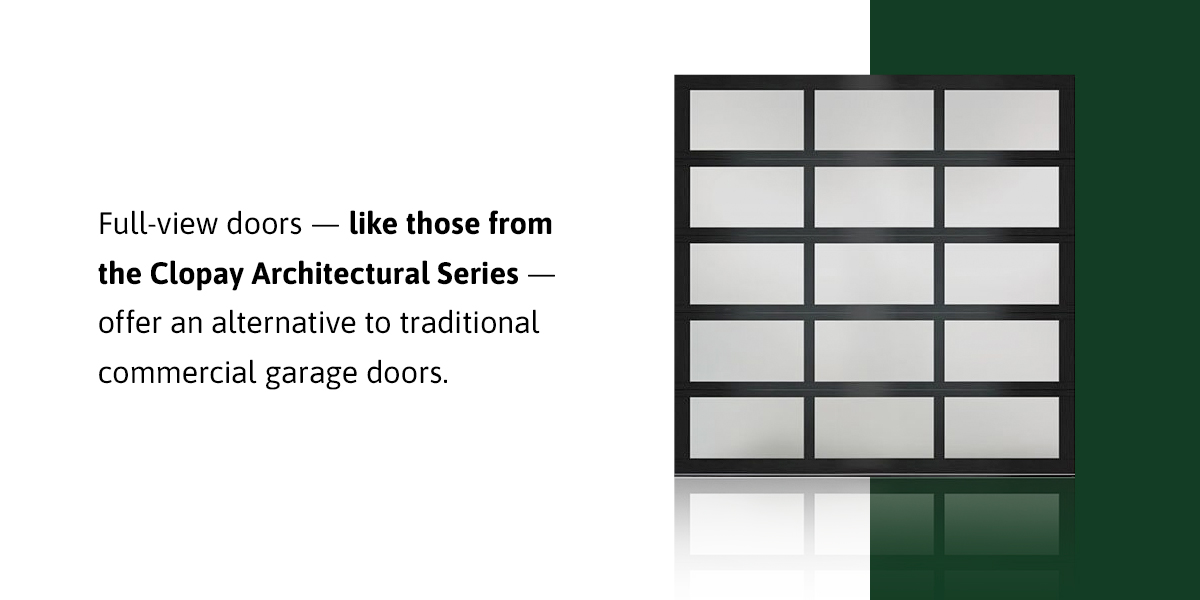
Schools or institutions with workshops and auto shops, like trade schools, typically use commercial-style garage doors. The same is true for campus security and school bus shelters. Depending on the application, you might use commercial overhead doors with fire protection features, rolling shutters, sectional designs or high wind load capacity. In any case, consulting a trusted expert for assistance is an excellent starting point.
Full-view doors — like those from the Clopay Architectural Series — offer an alternative to traditional commercial garage doors. They are common in areas where you want to maximize natural lighting and maintain visibility, like food courts or lobby areas. Full-view styles are available in steel and aluminum, each with different levels of insulation, durability and glass tempering.
Entry Doors in Schools and College Residential Halls
Whether you’re considering doors for resident halls or academic buildings, entry doors are essential across your campus. Common materials include fiberglass, wood, aluminum and steel, and most doors are versatile enough to customize to your school’s existing architectural design.
Entry Doors by Design Style
If appearance and style are important parts of your school’s features, consider these entry door favorites:
- Rustic: Rustic style retains a traditional feel with a touch of contemporary fittings. Rustic fiberglass entry doors may be inspired by Mediterranean or American Southwest architecture and often feature various panels and an attractive solid wood look. Rustic fiberglass entry doors are also insulated and durable, capable of withstanding shrinks, splits, rots and cracks.
- Craftsman: Craftsman-style entry doors are ideal for schools with a mission, bungalow or transitional-style architecture. Classic Craftsman designs feature wood or wood-like materials and rectangular windows with panels to establish depth.
- Smooth: Smooth fiberglass entry doors are the optimum choice for schools with contemporary architectural designs. They offer a clean, modern look with their smooth surfaces, rail lines and stile. These doors are engineered to last a lifetime, insulated with polyurethane foam and available in varying styles and glass options. They also have about 18 painting options and offer all the benefits of fiberglass.
If you’re remodeling an existing room, building or other unit, be sure to choose doors that blend with the existing style and layout.
Entry Doors by Material
If your school’s focus is longevity and maintenance, consider shopping for elementary and university campus doors by material. You can often combine multiple materials to achieve a desired look. The materials you select directly impact the door’s durability, maintenance, design and cost.
Fiberglass and steel are two timeless options for campuses:
- Fiberglass: The Arbor Grove™ fiberglass collection has the look and feel of natural wood grains with its random grain depths and all-natural wooden characteristics. Depending on your preferred glow and shade, these doors are available in multiple grain details, including cherry, mahogany and oak. These fiberglass doors are insulated with CFC-free polyurethane foam core, making them impervious to moisture and UV-resistant.
- Steel: Steel is known for two things — strength and aesthetics. Steel entry doors are ideal for schools that prioritize security. They may also help reduce energy bills and maintenance costs. Beyond that, they feature beautiful high-definition paneling for unique styles and shadow lines.
Residential Doors in Schools and Universities
Most schools in the U.S. use residential doors to secure and restrict access to private offices, dorms and student housing units. When choosing a residential door, consider the materials available and select one that best fits your needs. Steel and aluminum doors ensure maximum comfort and security without compromising aesthetics. Additionally, you can insulate the doors to reduce energy consumption or install fireproof models for optimum protection against fire.
The doors you select may also depend on where you install them. While soundproof materials such as glass may be ideal for music classrooms, sports areas and laboratory classrooms may require models that react well with fire and chemicals such as steel.
Choose Quality Door Company Today!
Doors are valuable in educational institutions to protect teachers, students, administrators and all persons on campus while offering privacy, security and style. Quality Door Company takes the load off your shoulders and helps you make an informed decision.
As a Clopay® Master Authorized Dealer®, we offer only the best doors for your school or commercial property. Contact us now to learn more, or request an estimate today!

